
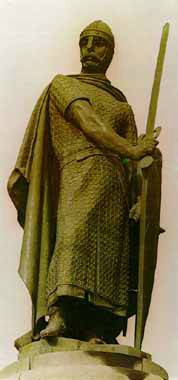 |
D. Afonso Henriques
(D. Afonso I, first king of Portugal).
A warrior's son and a fighter himself. His wish of independence became real in 1179.
|
Portuguese History
The Kingdom of Portugal emerged in the 12th century connected with the process concerning
the Christian reconquest of the Iberian Peninsula. At the same time that all the
territories occupied by the Moors were conquered southwards Portugal, originally a
county and a part of one of the most ancient Christian kingdoms of the Peninsula
- Leão - demanded its independence in 1143. Due to endless fights and negotiations D.
Afonso I, first king of Portugal, was awarded by the pope (1179) with the papal bull
manifestis probatum thus bringing stability. At the eyes of all the Christian
world, that meant the birth of a new kingdom in a part of the world were the fight against
the infidels would be reinforced by a backup force of attack (The Palestine and the Peninsula).
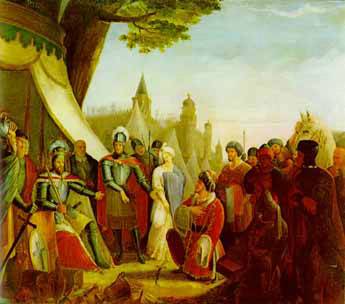 |
|
The D. Afonso Henriques girdle of Lisbon. A picture by Joaquim Rodrigues Braga (a
Portuguese artist from XIX century). Represents the surrender of the besieged.
|
The concept of crusade and the believe that all peninsular kings descent from an ancient
visigotic monarchy justified all the Southern process of conquest in the al-Andaluz. The
support of the church was unquestionable - the crusaders (conquest of Lisbon and Silves)
and the religious and military orders gave a big help to the birth of several kingdoms by
their endless effort of conquest and settlement.
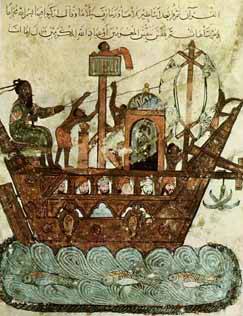 |
Portuguese mercantile navigation in XIV century was influenced by Arabic techniques.
In the picture we can see an Arabic pirate boat from XIII century. Portuguese people
learned a lot with the constant attacks from those vessels...
|
The peculiarity of the kingdom's formation lies in the various ways by the which the
territory was occupied. To all the well known European feudal forms of occupation - by the
nobility, by the clergy and the allotment, the council land is added. It is an autonomous
form serveyed between the king or the nobel and a community of free men, it derives from
an effort to populate deserted territories and it was carried out by kings and nobels
during the conquest process. The word council is still used in the modern local
administration.
The Arabic culture, which is clearly seen in several Portuguese cultural aspects, as been
since the beginning denied, especially because of the religious contrast by which it is
enveloped. However we must not forget the numerous quantity of words of Arabic influence
existing in our vocabulary.
Portugal was an expert concerning the technological development of cartography and navigation
and that enabled us in the 15th century of discoveries.
The inventions and the technical improvements have the most various roots, though
Portugal's geographical position and its cultural cohesion were a step ahead to find new
things. A nautical culture was being built.
 |
|
Lisbon in XVI century. Coloured and gilded decoration in a manuscript from 1520.
|
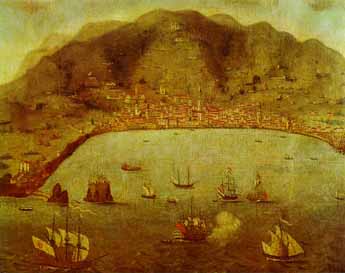 |
Madeira Island in a illustration from XVII century ...
and seen from the same place that the first navigator saw it...
|
The motivation to the great adventure was bottom line the food and workers scarcity.
Social and economic reasons do not justify such deed. In that period it was important to
fight the infidel and save souls. Foreign people (such as Italians or Catalonians, castilians,
bascs, northern Europeans and muslins) also wanted to take part on the crusade
enterprise but with their own interests.
Above all, the discoveries enterprise was seen as a way of increasing the national
patrimony and treasure.
In the beginning of the 15th century, due to the crisis felt through all Europe during
the 14th century, Portugal was dealing with serious economical problems.
It was urgent to find new resources, spereead the Christian belief to new people and
fulfil the desire to find/know new lands.
In that time the Infante D. Henrique, one of D. João I sons, took the responsibility to
make these journeys:
- The islands in the Atlantic were found: Madeira (1418) ; Azores (1427);
- We sailed around the Bojador Cape in 1434
- The western African coast was found until Sierra Lione in 1460 (the Infante died in the same year).
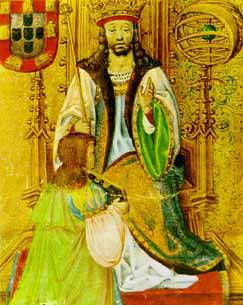 |
|
D.João II in a coloured and gilded decoration in a manuscript from the epoch.
|
From here on king D. João II was the leader of the Indies reached by sea sailing along
the African coast. The known maps showed that that was impossible to accomplish, for in those
maps the African coast was straight down until the south pole without any access to Indian ocean,
however the Portuguese navigators and merchants experience indicated that it might be
possible for them to connect the Atlantic ocean to the Indian ocean.
D. João II organised several voyages:
- Diogo Cão reached the Zaire (Congo) river mouth in 1483;
- Bartolomeu Dias sailed around the Cape of Good Hope, until than Known as Cape of the Torments, in 1487.
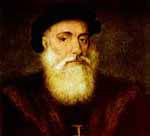 |
Vasco da Gama discovered the maritime route to India.
Died in 1524 as portuguese viceroy in India.
|
The doorway to the Indies was opened, the land of the spices and the luxurious products.
Meanwhile Spain had also joined the expansion race, and, to solve several conflicts the two
countries drawn a treaty in 1494, the Treaty of Tordesillas, in which they agreed to share
among them all the found or found-to-be lands.
Vasco da Gama reached the Indies in 1498, in the reign of D. Manuel I.
The second expedition sent to the Indies was commanded by Pedro Álvares de Cabral, but on
that voyage he officially found the Brazil in 1500.
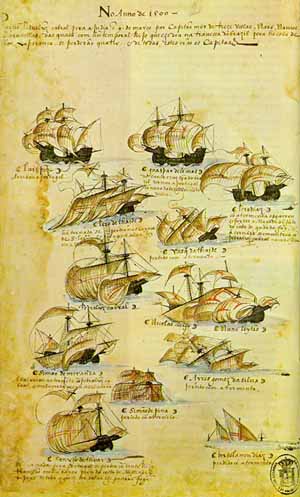 |
|
Pedro Álvares Cabral' Armada. Each boat as an indication of his own destiny.
|
The recent navigation knowledge was enormous. The Portuguese people in little less than a
century found new lands in a big part of the world. They maid bonds with people from different
continents.
They informed us about animals and plants that had never been seen before. Even the sky
and the stars looked different seen from the southern hemisphere.
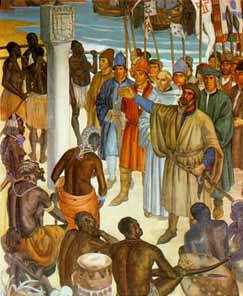 |
|
Diogo Cão is placing a stone monument in the mouth of Zaire river in
1482, replacing the first one that disappeared because was used as a
target in exercises from British navy artillery. |
One of the main reasons that lead the Portuguese to the expansion was the pursuit of wealth.
Whenever they reached a new land they tried to take as much advantage of it as they could.
In the 16th century Portugal had dominion over areas from the Atlantic until the Far East,
making it altogether a vast empire.
The new worlds that Portugal found melted together. They learn the ideas, the techniques,
the knowledge and the every day life of one another. Out of all these exchange of ideas
one thing is for sure, a new world emerged.
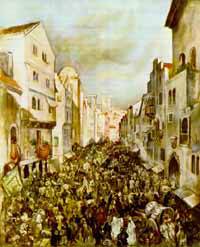 |
|
Rua Nova dos Ferros. This street in Lisbon in XIV century reports one important European
town. Lisbon became a important centre of ultramarine enterprise. The population was
really heterogeneous and had a continuance of growth and activities.
|
A new sensibility, a new taste and a new knowledge were brought in to a light with the
discovery voyages made in 16th century. The culture, the science, the arts, the literature
were given new impetus.
Lisbon in 16th century was the capital of an empire, it became the trade centre. Its
geographical position was fundamental. The city became the meeting point of all europeans,
who soon would settle in Lisbon, from Africa slaves were brought (in the 16th century,
in Lisbon, 10 out of 100 were slaves) people from all over the world arrived to Lisbon
seeking a better way of life. On the other hand, others would leave to the new world seeking
adventure.
While Lisbon was becoming one of the most important and busiest cities of the world, the
rest of the country had stagnated.
The maritime commerce was largely profitable, but that money was not directed to the
agriculture or handcraft industry development, therefore every consumer goods were
imports. The national expenses soon became larger than the profits.
By the end of the 16th century there was a succession problem, for D. Sebastião
disappeared in the Ksar el- Kebir battle in 1478. Portugal was then ruled by a Spanish
king. Though at beginning Portugal had same benefits with this fusion, by the 17th century
the situation was different it was that this integration in the big empire of Carlos V's
successors brought a higher tax pressure along with all the empire troubles: participation
in wars which Portugal had nothing to do with (the Spanish Armada); the loss of influence
in the colonies (Dutch advance in South America).
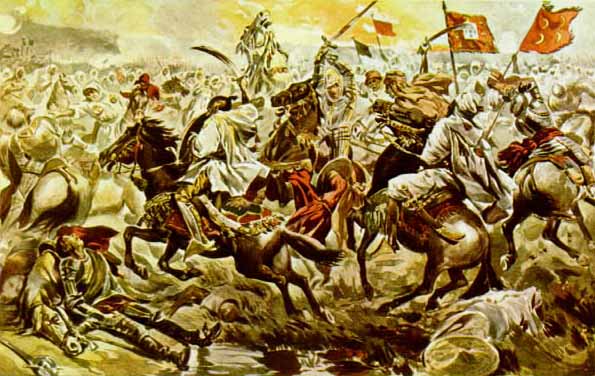 |
|
Alcácer Quibir battle. Also known as the battle of the 3 kings (because
of the dead of the Portuguese king and 2 mussulman leaders). D.
Sebastião disappearance during this suicidal mission was responsible
for the beginning of a legend that tells about the return of the
desired king ... |
The independence process began in December, 1., 1640 and ended in 1668 when a peace treaty
was sign were Spain granted Portugal its independence. This is not an isolated riot, many
others took place during the Phillips Dynasty which led to there decay (Catalunian uprise, ....).
After achieving the independence it was of major importance to get back the lost empire,
Portugal did not rule anymore in the found lands, the Cape Route was now in the hands of
the British, the Dutch and the French. Brazil looked like a good solution to the weakened
Portuguese economy, they had the sugar production during the 17th century and lots of gold
in the 18th century.
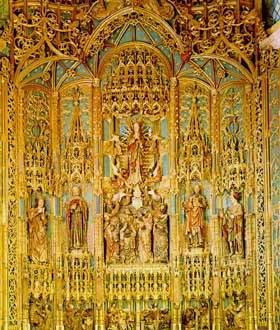 |
A retable of wood polychromated in blue and dory. It is a magnificent production
inspired in the north gothic.
This kind of work was possible because (as the great and fantastic Portuguese art at the
epoch) of the economic power that the ultramarine profits made possible.
|
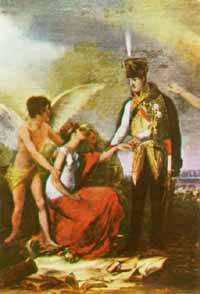 |
Junot and Lisbon. Detail from a Domingos Sequeira' sketch.
Junot was one of the militar responsible for the French invasion.
|
The echoes of the French revolution were also felt in Portugal, ending with the Ancient
Regime (Antigo Regime). The ideals of this revolution were in a way gladly acknowledge by
some people, however they were violently imposed by three invasions (1807, 1808, 1810).
The royal family fled to Brazil keeping Portugal's independence and its government, even
ruling from overseas. Meanwhile the British, taking advantage of several popular uprisings
all over the Peninsula against the French dominion, send troops to another European battle
field.
With the end of the Napoleonic Wars, England enjoys a privileged governmental position
controlling all commercial relationships with the colonies and the rest of the world
(Oporto and Madeira wine).
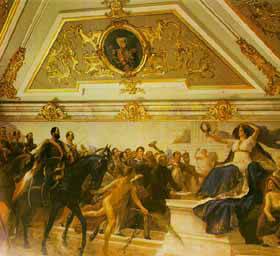 |
|
Motherland crowning the heroes from the liberal fights. This is a painting by Veloso
Salgado.
|
While the king was still in Brazil there a was in Portugal and uprising against Beresford
(Who represented the British interests in Portugal), the idea was to expel him out of the
country. People were getting angrier every day and the acceptance to the French Revolution
ideals - Liberty, Equality and Fraternity - was growing. So, in 1820 a group of liberals
organised an uprising in Oporto that spread through out the country.
Government was set in the hand of a temporary committee whose task was organise the first
elections and write a constitution, which would be published in 1822. That is how a
constitutional monarchy was born. The loss of Brazil in 1822 shows a period of troubled
times to the liberals. The remaining supporters of an absolute system went to a civil war
that lasted until 1834, the liberals won the war, they were led by D.Pedro, brother of the
leader of the absolutist wing, D.Miguel.
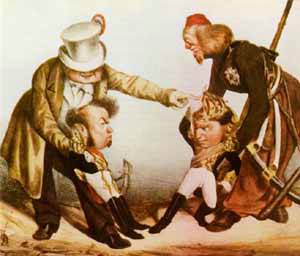 |
|
D.Pedro and D.Miguel. A cartoon that caricatures the international interests behind each
brother during the civil war.
|
Liberal governments do serious agrarian and industrial reforms in the country, and also in
transports and public affairs. It is obvious that the progress in commerce is due to the
development of the communications.
The technological delay, the lack of capital, loosen investments, the foreign competition
in main economical sectors, opposite policies of development led to a slight gap between
Portugal and the rest of the world.
Like the Berlin Conference (1884-85) has confirmed, other European major countries were
looking for new markets and raw materials, but Portugal was far back in this race, though
without enlarging its possessions, Portugal still maintained, with some effort, the
colonies. There were many problems with which the monarchic government could not deal with:
in one hand the people unsatisfaction, and in the other hand the growing group of
republican supporters that were against the government. In fact on 1. February of 1908 in
an attack against the royal family D.Carlos and the heir prince D.Luís Filipe, are killed.
D.Manuel II (the second son of D.Carlos) was recognised king of Portugal by the end of
that same year. He was the last king of Portugal. During the two last years of is reign
the revolution movements did not stop growing.
In October 5. 1910 it was proclaimed the Republic in Lisbon, the royal family was expelled
out of country. The first temporary cabinet declared:
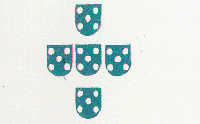 |
The five shields of the Portuguese arms are representative of the five Islamic kings that
D.Afonso Henriques defeated at the Ourique battle.
The points inside each shield are representing the five wounds of Christ.
|
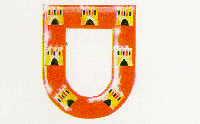 |
|
The seven castles are the five fortified villages conquered by D.Afonso Henriques
from the moors.
|
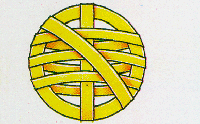 |
|
The armillary sphere is the symbol of the world that portuguese navegators discovered in the
XV and XVI century
|
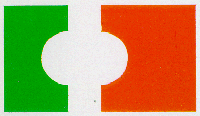 |
The green is the colour for hope in the future.
The red is the symbol of the courage and blood spilled by Portuguese soldiers
on the battle field.
|

|
- The national hymn «A Portuguesa»
- The nowadays known flag
- Abolished all nobility ranks
- Abolished the religious swear at trials
- laws protecting the family (civil marriage, the end of illegitimate child status)
- Laws concerning free press
- Labour rights (strike, weekly rest, social bonus)
- The lock-out right
All these measures were set in the first Constitution of the Portuguese Republic of 1911.
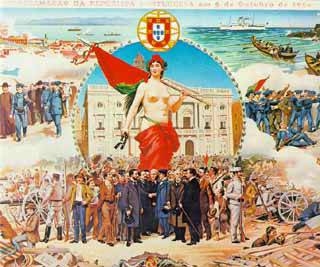 |
|
A commemorative illustration about the Republic Proclamation in 5.October in 1910
published at the time as a post card.
|
However the economic weakness and the political immaturity of the congress members led to
a huge social and political instability.
War times were also lived in this particular period: between 1910 and 1926 Portugal had
height presidents and 45 congresses.
But not all was bad, the first republic changed areas like the education and culture, the
compulsive school, and the grade birth of new universities.
This situation of political instability leads to a military coup in 1926, a military
dictatorship was declared. The press began being censured and all liberties were
diminished. This militar dictatorship turned it self into a real absolute regime of
fascist tendency like many others throughout Europe who sought in a strong government the
answer to all their problems.
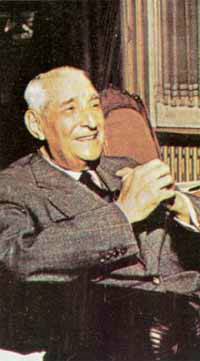 |
Salazar was the face of the power for almost 40 years...
This picture is one rare photography just because he was smiling...
|
This regime is strengthened by the nomination of Salazar to the government and with the
proclamation of a new constitution in 1933, that set a new authoritarian regime - Estado
Novo.
The Portuguese unicity is also seen here, for unlike its Europeans partners, Portugal
does not show much interest about industrialisation and has not broken its bonds with
the church, remember the motto: god, motherland and family.
During the Salazar regime the Portuguese economy was almost stagnant. Many efforts were
made to diminish the state expenses.
Agriculture continued to be the main activity of the population and kept the technological
delay. The access to education was conditioned. The third sector was slowly developing.
Despite the development of some industries unemployment spread and life conditions were
getting tougher.
Between 1960 and 1970 many people immigrated especially to France and Germany. Some
political opponents to the government also immigrated, like Mário Soares and Álvaro Cunhal.
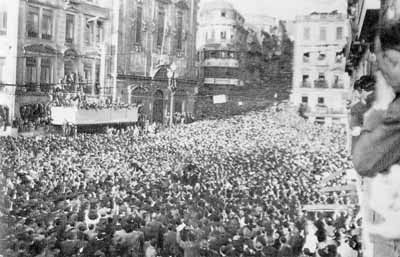 |
A moment in time during the political campaign to the elections in 1958. He lost the
elections to the government machine that manipulated the results.
Delgado, known as the no fear general, was murdered in 1965 by the Portuguese political
police.
|
Once the second world war was over a anti-colonies spirit spread. To many European
colonies in Africa and Asia independence was granted. In 1961 also the African colonies
start a guerrilla war seeking independence from the metropole. To support the war it was
necessary to send thousands of soldiers to Africa, along with a suplementar economic
effort. The Portuguese colonial war was on for 13 years, thousands of soldiers fell in
battle, many physically challenged returned from the war, the Portuguese people had to
deal with heavy expenses to support all them.
The lasting of the fascist regime and the colonial affair led Portugal to a gradual world
political isolation. The connection of Portugal with NATO, UN and EFTA did not granted
Portugal the international community acceptance of the Portuguese position.
The desire of freedom, the unsatisfaction towards the government and the war in Africa were
some of the causes to the government overthrow, on the 25th of April of 1974, led by an army group.
That is how a second Republic was born, democracy was back again after 48 years of
dictatorship.
In May was gathered the first temporary cabinet with members of all the political parties.
During this government was followed the programme written by the army group:
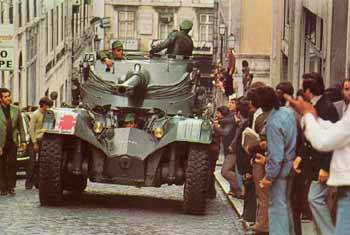 |
|
Soldiers and people in April 1974. This became a symbol of Portuguese revolution to
democracy. The first civil president took over only in 1986!!
|
- The constitution of political parties and unions was declared legal;
- The organisation of free elections;
- The extinction of the political police;
- Censorship was abolished;
- All political prisioners were set free and the exiled were authorised to return to
they motherland.
The 25. of April of 1974 brought to the Portuguese people the freedom of thought and
speech and the peace along with the independence of all the colonies.
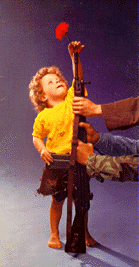 |
|
This photo is a symbol to Portuguese people: the innocence of a child and a flower are
(or must be) stronger than a machine gun...
|
On the 25th of April of 1975 took place the first free election (in 50 years), the aim was
to elect a representative convention that later wrote a new Constitution published on the
2nd of April 1976. This Constitution set new basics to a new democratic government and to
the performance of the institutions, as well as to the participation of the citizens in
the political, social and economic life and the autonomy of the local power.
The new challenge that Portugal get in to through deals with the formation of the EC, of
which is a member since 1986.
Today there are eight countries which official language is the Portuguese. It is the 5th
language that is spoken all over the world.
The political maturity brought Portugal a new conception off identity. Portugal and his
Portuguese spoken fellows created CPLP (Comunidade dos Países de Língua Portuguesa), a
Community of Countries with Portuguese as their official language. This community,
among other things, pretends to bee the cultural and linguistic link between those
countries (from America, Africa or Asia). For them, Portugal is the doorway into
Europe and a window to the world. To Portugal they are the link to world... The new world
again.
The international community has already recognised the CPLP importance. In 1st November
off 1999 CPLP assumed a new role as an international observator in the UN.
A.P.H. 2000
|